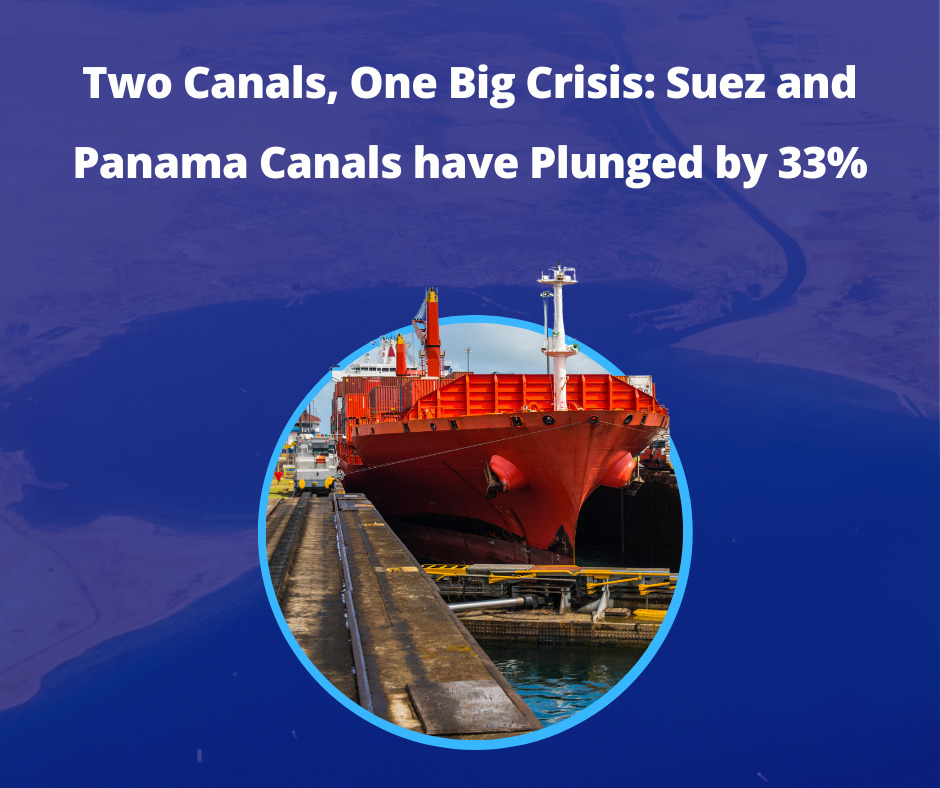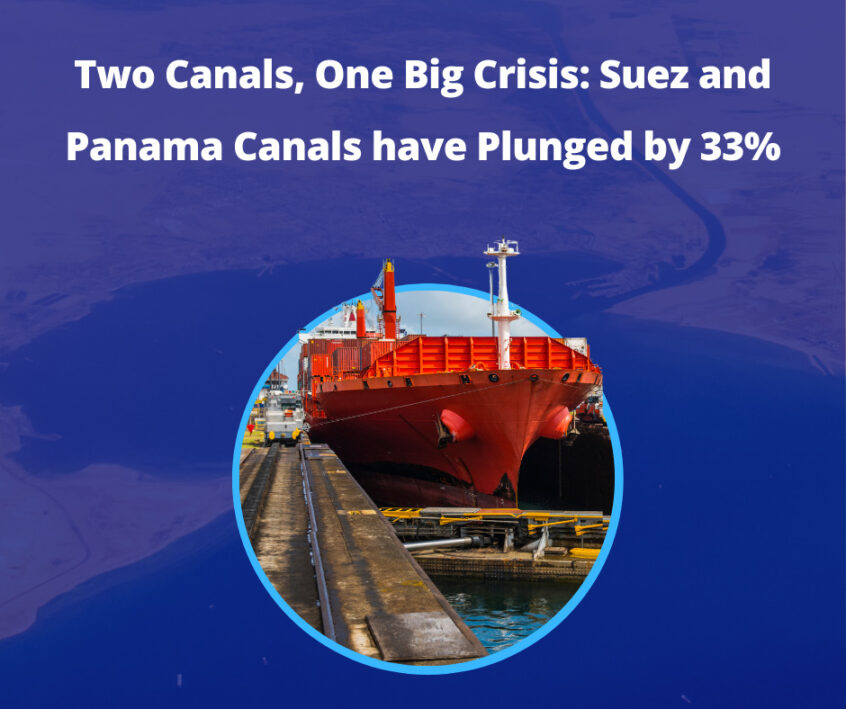
One Global Shipping Mess
Navigating the challenges of the Panama and Suez Canals has become a pivotal concern for the global logistics and shipping industries. These critical waterways, essential for the seamless flow of international trade, face unprecedented issues that have ripple effects on global supply chains, trade volumes, and freight costs.
This article explores the significant impacts of the dilemmas plaguing the Panama and Suez Canals, delving into their causes, consequences, and broader implications for the logistics sector. Through an examination of water scarcity, geopolitical tensions, and the urgent need for sustainable solutions, we aim to provide a comprehensive overview of the current situation and its potential future trajectory.
The Crux of the Crisis
Drought and Water Management in the Panama Canal
The Panama Canal, an engineering marvel that has facilitated global trade by connecting the Atlantic and Pacific oceans since its opening in 1914, is facing an unprecedented challenge. Over the past century, the canal has endured various hurdles, but the current drought stands as one of the most severe. This environmental crisis has far-reaching implications, not just for the maritime industry but also for the local ecosystem and the people of Panama.
The Severity of the Drought
The drought affecting the Panama Canal is among the worst in its operational history, with water levels in Lake Gatún, the canal’s main freshwater source, reaching critically low points. Lake Gatún, created during the canal’s construction, plays a pivotal role in the functioning of the canal’s lock system, which requires substantial volumes of water to operate. Normally, the lake’s water level is maintained at about 85 feet above sea level to ensure the smooth passage of vessels through the canal’s locks. However, recent reports have indicated that water levels have fallen to around 81 feet, significantly below the operational threshold.
This drastic reduction in water levels is attributed to a combination of factors, including below-average rainfall and the effects of the El Niño weather phenomenon, which exacerbates dry conditions in the region. Statistical data from the Panama Canal Authority (ACP) underscore the gravity of the situation, with last October being recorded as the driest month in the canal’s vicinity since records began. The region experienced 41% less rainfall than average, contributing to the acute water shortage.
Impact on Canal Operations
To manage the diminished water supply, the ACP has been forced to implement several water-saving measures. One of the most significant actions has been the reduction in the number of daily ship transits. Historically, the canal could accommodate an average of 36 vessel crossings per day. However, due to the drought, this number has been reduced to approximately 24 crossings, severely limiting the canal’s capacity to handle global maritime traffic.
Furthermore, vessels passing through the canal now face weight restrictions. The reduced water levels in Lake Gatún necessitate lower draft limits for ships, meaning they must carry less cargo to decrease their displacement and ensure safe passage through the locks. This measure directly impacts shipping companies’ operational efficiency and profitability, as they must either lighten their loads or seek alternate routes, both of which entail increased costs and logistical complexities.
Broader Implications for Global Trade and Local Communities
The ramifications of the drought extend beyond the shipping industry. The Panama Canal is not only a vital artery for international commerce, with about 5% of global maritime trade passing through it, but it also supplies fresh water to nearly half of Panama’s population, including the metropolitan area of Panama City. The water crisis threatens freshwater availability for millions of people, posing serious public health and socio-economic challenges.
Economically, the slowdown in canal operations disrupts supply chains worldwide, affecting everything from consumer goods to energy resources. The reduced capacity of the canal contributes to longer delivery times and higher transportation costs, which can inflate product prices and strain global markets already reeling from various disruptions.
Looking Ahead: Strategies for Mitigation and Sustainability
In response to the crisis, the ACP is exploring long-term solutions to secure the canal’s future viability and water sustainability for the region. These include investing in infrastructure projects aimed at enhancing water conservation, such as constructing new reservoirs and implementing advanced water management technologies. For example, the expansion of the canal completed in 2016 introduced new locks designed to save water by recycling it between filling and emptying processes.
Moreover, the ACP is considering more radical solutions, such as the potential construction of desalination plants to supplement freshwater supplies. While costly and energy-intensive, desalination could provide a crucial buffer against future droughts, ensuring both the canal’s operational integrity and the water security of the surrounding communities.
The challenges faced by the Panama Canal highlight the broader issues of climate change and resource management confronting the global logistics industry. As the world grapples with increasing environmental volatility, the experiences and responses of the Panama Canal offer valuable lessons in resilience, innovation, and sustainability.
Geopolitical Tensions and the Suez Canal
Simultaneously, the Suez Canal is facing problems as well. This essential conduit for maritime trade between Europe, Asia, and the Americas, is navigating its turbulent waters amidst escalating geopolitical tensions. This vital artery, responsible for the smooth transit of a significant portion of the world’s shipping traffic, has recently become a focal point of instability in the Red Sea region. The strategic implications of this volatility are profound, affecting global trade volumes, shipping costs, and the resilience of supply chains already strained by the Panama Canal’s drought-induced limitations.
Geopolitical Tensions and Their Impact
The Suez Canal’s strategic importance cannot be overstated, facilitating the passage of approximately 12% of global trade. However, the increasing geopolitical unrest in the Red Sea region has introduced new risks to this critical maritime route. Incidents such as attacks on shipping vessels have not only raised security concerns but also led to significant disruptions in maritime traffic flow. In response, shipping companies, wary of potential threats to their assets and crew, have begun seeking alternative routes, despite the longer journey times and higher costs involved.
Rerouting Ships: A Costly Decision
The decision to reroute vessels around the Cape of Good Hope, for instance, adds thousands of miles to the journey between Europe and Asia. This detour significantly increases fuel consumption and voyage duration, with estimated additional costs reaching up to $300,000 per voyage for a typical large container ship. Such rerouting decisions have a cascading effect on trade volumes passing through the Suez Canal, with a notable decrease in transits contributing to a reduction in canal revenues and impacting global shipping schedules.
Consequences for Global Trade and Supply Chains
The ripple effects of the Suez Canal’s challenges are felt across global supply chains. Increased shipping costs and extended delivery times contribute to higher prices for goods and materials worldwide. For industries reliant on just-in-time delivery models, such as automotive and manufacturing, the delays can lead to production slowdowns and inventory shortages. Furthermore, the need to navigate around geopolitical tensions adds a layer of complexity to logistic planning, compounding the uncertainties faced by businesses in an already volatile market environment.
Mitigating Strategies and Future Outlook
In the face of these challenges, shipping companies and global traders are adopting various strategies to mitigate risks and manage costs. These include diversifying shipping routes, enhancing security measures for vessels transiting high-risk areas, and adjusting inventory management practices to accommodate longer transit times. Moreover, the industry is closely monitoring developments in the region, with a keen eye on diplomatic efforts aimed at stabilizing the situation and ensuring the safe passage of maritime trade through the Suez Canal.
Governments and international bodies are also playing a crucial role, working to de-escalate tensions and protect this vital maritime corridor. Initiatives aimed at enhancing maritime security, such as increased naval patrols and cooperation between countries, are critical to safeguarding the Suez Canal’s role in global trade.
Wrapping Up
The dilemmas facing the Panama and Suez Canal represent a microcosm of the broader challenges confronting the global logistics and shipping industries. Addressing these issues requires a concerted effort from governments, industry stakeholders, and the international community to invest in sustainable solutions, adapt to changing geopolitical landscapes, and foster innovation. As the industry navigates these troubled waters, the lessons learned and strategies implemented will not only shape the future of maritime trade but also highlight the importance of resilience and adaptability in a rapidly changing world.



